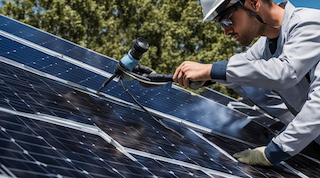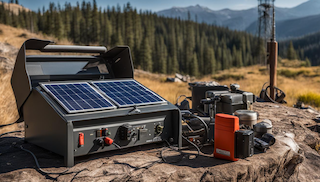In emergency situations, people often weigh the pros and cons of hand cranks and solar arrays as viable options for an emergency power source. By understanding the advantages and drawbacks of each option, we can make informed decisions about how best to prepare our survival kit for SHTF (Shit Hits The Fan) scenarios. This article will explore the adaptability and reliability of both hand-crank devices and solar-powered solutions to help you decide what’s best for your personal preparedness plan.
Key Takeaways
- Hand cranks offer multiple power sources and can be easily charged with human power, making them adaptable in emergency situations.
- Solar arrays provide a limitless and clean source of energy that is particularly valuable in long-term off-grid situations.
- Durability, weather resistance, and power-generation capacity are essential factors to consider when evaluating both hand crank radios and solar power solutions.
- Recent technological advancements have made solar power solutions more efficient and reliable for emergency situations.
- Considering personal needs, environment, and potential duration of an off-grid scenario will guide your decision-making process for SHTF energy needs.
The Essentials of SHTF Preparedness: Hand Crank vs. Solar Array
In preparing for SHTF (Shit Hits The Fan) scenarios, it is essential to choose between a hand crank radio or a solar array based on their unique attributes. Hand crank radios, with their ability to charge through human power, offer adaptability in the absence of electricity. On the other hand, solar power solutions like foldable solar panels and solar-powered generators provide a more sustainable and longer-term power supply, as long as sunlight is available. Survival energy options should be reliable; thus, practical considerations of durability, weather resistance, and power-generation capacity are paramount.
Both hand crank radios and solar power solutions have their strengths and weaknesses in terms of emergency power sources. It is important to weigh the pros and cons of each option when assembling your off-grid power solutions for SHTF preparedness. To aid you in this decision-making process, here is a comparative table between hand crank radios and solar power solutions:
| Attribute | Hand Crank Radios | Solar Power Solutions |
|---|---|---|
| Adaptability | Can charge through human power, making it usable in the absence of electricity | Offers a consistent power supply, provided that sunlight is available |
| Durability | Must be sturdy and able to withstand rough usage | Solar panels and generators must be durable and capable of withstanding outdoor conditions |
| Weather Resistance | Must be resistant to water, dust, and other environmental factors | Must be able to perform in various weather conditions, such as extreme heat, cold, or rainfall |
| Power-Generation Capacity | Depends on the physical effort put into cranking the device | Requires sunlight and may not be as effective in cloudy or rainy conditions |
When making a decision, it’s crucial to consider factors such as your geographical location, your specific needs, and the potential duration of an off-grid scenario. For instance, if you live in an area with frequent sunlight, solar power solutions may be a viable option. However, if you reside in a location with limited or inconsistent sunlight, a hand crank radio may serve as a more adaptable and reliable resource.
“Choose wisely between hand crank radios and solar power solutions for your SHTF preparedness, ensuring that you have a reliable emergency power source for any situation.”
To further enhance your SHTF preparedness, consider the following:
- Invest in quality hand crank radios or solar power solutions from reputable brands
- Regularly test your equipment to ensure proper functionality
- Include additional power sources, such as portable battery packs or generators, as part of your off-grid power solutions
- Stay informed about emerging technologies and developments in the field of renewable energy sources
In conclusion, carefully assessing the attributes of hand crank radios and solar power solutions is vital in developing a comprehensive and effective SHTF preparedness strategy. By considering factors such as adaptability, durability, weather resistance, and power-generation capacity, you can ensure a reliable emergency power source for any off-grid situation.
Analyzing Hand Crank Radios for Survival: Features to Consider
Supported Frequencies and Emergency Channels
Modern hand crank radios are designed to access a variety of frequencies, including AM and FM bands, as well as weather channels from the National Weather Service to provide up-to-date information during emergency situations. These frequencies offer access to entertainment, sports, and local broadcasts, making them an essential part of your emergency power source toolkit. One critical feature offered by hand crank radios is access to NOAA emergency weather updates, providing real-time information about regional emergencies like storms, natural disasters, and other time-sensitive events. Be sure to select a radio that supports these high-frequency NOAA transmissions, as they are not accessible on regular FM radios.
Durability and Weatherproof Ratings
When choosing a hand crank radio, durability is a vital factor to consider. The best hand crank radios come with weatherproof ratings, ensuring they can withstand damage caused by water, dust, and other elements to provide uninterrupted service during crises. Weatherproof ratings like IPX4 and IPX6 signify various levels of resistance, allowing your radio to function effectively in emergencies and provide critical information updates. When selecting a hand crank radio for your survival kit, look for one that is built to endure harsh conditions and can serve as a reliable portable renewable energy source.
Charging Capabilities and Additional Functionalities
Advanced hand crank radios now come equipped with a range of charging options to generate alternative power when traditional sources become unavailable. Onboard batteries can be recharged using solar panels or USB ports, while manual cranking provides immediate access to power when needed most. Common battery sizes range from 2000mAh to 10000mAh, offering extended use for radio or flashlight applications.
- Built-in LED flashlights
- SOS alarms
- Telescoping antennas
- USB device charging ports
These additional features expand the usability of hand crank radios, providing essential services during emergency situations. By selecting a radio that offers these functionalities, you’ll add a vital component to your survival kit that covers multiple multi-power-source options and helps ensure you’re prepared for any situation.
Solar Power Solutions: Harnessing the Sun’s Reliability in Emergencies
In the face of emergency scenarios, solar power solutions become increasingly important due to the sun’s abundant and clean energy. Solar-powered survival gear, such as foldable solar panels, generators, and radios, offers reliable power in dire situations. With the advancements in sustainable energy solutions, solar power has become a pillar of reliable emergency preparation.
A prime example of a reliable solar-powered solution is a solar panel capable of producing 120 watts of maximum power. These panels, equipped with high-efficiency SunPower cells, can operate in a wide range of temperatures, enabling them to provide electricity in extreme environmental conditions. Moreover, their compatibility with various solar-powered survival gear makes them essential in long-term blackouts or natural disasters.
“The sun is the most reliable source of energy we have, and harnessing that energy for emergency scenarios can be a game-changer in terms of preparedness.”
- Solar-powered generators
- Foldable solar panels
- Solar power banks
- Solar-powered radios
From the list of solar-powered equipment mentioned above, it becomes evident that solar power solutions offer a versatile range of applications suitable for various emergency scenarios. In contrast to hand crank radios, solar-powered devices provide clean and sustainable energy to keep essential electronics running as long as there is sunlight available.
Table: Comparing Solar Power Solutions and Hand Crank Radios in Emergencies
| Specification | Solar Power Solutions | Hand Crank Radios |
|---|---|---|
| Energy source | Sunlight | Manual Cranking |
| Reliability | As long as there is sunlight | Depends on user’s ability to crank and device battery life |
| Compatibility with other devices | Can charge multiple devices, such as phones, tablets, and laptops | Limited to devices specifically designed for hand crank charging |
| Environmental impact | Green energy with no emissions | Minimal environmental impact, but limited power generation |
As the table shows, solar power solutions offer a broader range of applications, reliability, and compatibility compared to hand crank radios in emergency situations. Therefore, investing in and utilizing solar power solutions can significantly improve one’s preparedness and chances of survival during emergencies.
Advantages of Solar Arrays for Sustainable Energy in Off-Grid Scenarios
Solar arrays offer numerous benefits for those seeking sustainable energy solutions in off-grid scenarios. As a clean and renewable power source, solar energy provides a practical alternative for emergency situations or complete independence from the grid. In this section, we will explore the main advantages of using solar arrays as an off-grid power solution, focusing on the 120 Watt foldable solar panel as a key example.
- Reliable power source: Solar panels harness the sun’s energy to generate electricity, providing a steady power supply even during emergencies. With the proper setup and battery storage, solar arrays can ensure power availability throughout the day and night.
- Environmentally friendly: Solar energy is a clean and green alternative to conventional power sources. By using solar arrays, you can minimize your environmental impact and promote the use of sustainable energy solutions.
- Portable and convenient: Products such as the 120 Watt foldable solar panel make it easy to set up a solar power system in off-grid locations. This portable solar panel can be folded and transported easily, allowing you to generate electricity wherever you need it most.
- Low maintenance and durable: Solar panels generally have a long lifespan and require little maintenance, making them an attractive option for long-term off-grid power. Quality solar panels can withstand various weather conditions and continue operating efficiently for years to come.
- Cost-effective: While the initial investment for solar arrays may be significant, the long-term savings on energy costs can be substantial. By using solar energy to power your off-grid location, you can reduce or even eliminate your reliance on traditional power sources, ultimately lowering your energy expenses.
Investing in solar arrays for off-grid scenarios provides clean, reliable, and sustainable energy solutions, empowering individuals to minimize their environmental impact and promote the use of renewable energy sources.
In conclusion, solar arrays offer a multitude of advantages for off-grid power, particularly through products like the 120 Watt foldable solar panel. By harnessing the power of solar energy, you can ensure a reliable and sustainable energy solution that is both environmentally friendly and cost-effective. Solar arrays not only provide a viable alternative to traditional power sources but also play a pivotal role in promoting a greener future.
Understanding the Limitations of Hand Cranks in Prolonged SHTF Situations
Hand cranks are invaluable emergency power sources, providing users with a backup power system during SHTF scenarios. While these devices are portable and immediately accessible, there are certain limitations that should be taken into consideration, especially in prolonged situations.
Battery Life and Manual Charging Efficiency
One of the key drawbacks to using hand cranks is the dependence on physical labor for power generation. Although hand crank radios equipped with larger batteries can provide extended usage times, they still rely on manual charging efforts. In prolonged SHTF situations, this can become inefficient and exhausting, as users must continuously allocate energy and time to charging.
Keep in mind that despite a longer battery life, manual charging efforts may not be feasible in extended survival scenarios.
Practical Constraints of Portable Crank Devices
Portable crank devices exhibit practical constraints, such as their reliance on human power and potential fatigue during continual use. Some devices have received criticism for their inability to reliably charge smartphones and their insufficient solar charging capabilities. For example, the Solar Crank CR-1009 has been scrutinized for these shortcomings, displaying risks during real emergency situations, where trustworthy power is crucial.
The following table details the pros and cons of hand cranks:
| Pros | Cons |
|---|---|
| Portable and accessible | Dependent on physical labor for charging |
| Multi-power-source options available | Manual charging can be exhausting and time-consuming |
| Can charge other devices (e.g., smartphones) | Limited efficiency in prolonged SHTF situations |
It’s important to carefully consider the limitations of hand cranks when selecting an emergency power source. Assess the individual needs and requirements for your specific situation, ensuring that your survival energy options are reliable and adaptable to the challenges of prolonged SHTF scenarios.
Evaluating Solar Array Performance: Real-World Testing and Considerations
When it comes to solar array performance, real-world testing is essential for determining their effectiveness as an emergency power source. Given that each situation and environment is unique, it is important to understand the capabilities of a solar powered generator in various conditions, especially during emergencies.
Reliability is a major concern in these scenarios, which is why thorough testing must be conducted to evaluate the efficiency of solar arrays in terms of power generation and device charging. Let’s take a look at some crucial aspects of solar array performance that warrant attention:

- Capacity to charge devices: A successful solar array should be able to effectively charge essential devices, such as smartphones, tablets, and laptops, which can prove invaluable during an emergency situation.
- Powering essentials effectively: Apart from charging devices, solar arrays should be able to steadily provide power to crucial appliances, such as refrigerators and lights, ensuring basic needs are met during prolonged power outages.
- Compatibility with generators: The ability of a solar panel to charge a 716-watt-hour battery pack in a generator demonstrates the potential of a solar array to maintain multiple devices and supply consistent power.
- Performance in various conditions: Solar arrays need to deliver power in a range of conditions, such as during cloudy or partially shaded periods, ensuring people always have access to a reliable energy source.
It is essential to acknowledge that technological advancements have significantly contributed to the increased efficiency of solar power systems. As they continue to evolve, solar arrays will only become more useful in offering a sustainable and reliable source of energy during emergencies.
Real-world performance of solar arrays can shed light on their true capability to deliver steady power in various conditions, ultimately determining their effectiveness as an emergency power source.
In conclusion, evaluating solar array performance through real-world testing is vital for understanding their capacity to provide sustainable and reliable power during emergencies. Factors such as device charging, powering essentials effectively, compatibility with generators, and performance in various conditions should all be taken into account when assessing a solar array’s true potential as an emergency power source.
Compatibility of Hand Crank Devices with Other Survival Gear
When evaluating emergency preparedness options, it is essential to assess the compatibility of hand crank devices with other survival gear. An integrated emergency kit should work seamlessly together, enabling users to face emergency situations effectively.
Hand crank devices offer several capabilities that complement other survival gear. Many hand crank radios have built-in flashlights and can charge essential devices like mobile phones. These features are a crucial part of any emergency kit, providing you with communication, access to information, and an emergency light source.
However, it is important to consider the limitations of hand crank devices when planning your overall survival strategy. When assessing the compatibility of a hand crank device with other survival gear, one should bear in mind the power generation ability of these devices. Despite their self-powering nature, hand crank devices require manual labor which may not be feasible in all circumstances.
While hand crank devices add valuable functions to your survival gear arsenal, bear in mind that their power generation capabilities might be limited in prolonged emergency situations.
Moreover, hand crank devices may not be compatible with all emergency equipment due to varying connector types or voltage requirements. When selecting a hand crank device, ensure that it has the necessary connectors or adapters for seamless integration with your other survival gear. This will ensure that your renewable energy sources can reliably power your equipment during emergencies.
- Combining a hand crank device with other renewable energy sources, such as solar panels or additional battery packs, can create a more robust power solution for extended emergency situations.
- Consider the weight and size of your hand crank device, as it plays an essential role in the manageability and portability of your emergency kit.
- When assessing compatibility with other survival gear, confirm that your hand crank device has sufficient durability and weather resistance to withstand harsh conditions, especially if the device is designed for outdoor use.
In conclusion, when evaluating the compatibility of hand crank devices with other survival gear, it is essential to not only consider the beneficial features but also recognize their limitations to ensure an effective and well-rounded emergency preparedness kit.
Future-Proofing with Solar Arrays: The Long-Term Off-Grid Power Solution
The growth in sustainable technology leads to advancements in solar panel efficiency and versatility, making solar arrays an ideal method for future-proofing energy needs. Their capacity to consistently produce power during emergencies along with their adaptability makes them a reliable off-grid power solution.
Large Scale and Portable Solar Panel Options
As solar arrays evolve, their production capabilities range from large-scale to portable options. Although larger panels tend to be cumbersome and challenging to transport, portable and foldable solar panels provide a viable alternative without sacrificing power generation. For instance, Goal Zero’s Nomad 100 Solar Panel offers a 100-watt output, making it a practical choice for meeting energy needs in emergency situations.
Portable solar panels provide the dual benefits of convenient transportation and powerful energy generation, making them essential components of a well-rounded disaster preparedness strategy.
Linking Solar Arrays with Other Renewable Energy Sources
Integrating solar arrays with other renewable energy sources establishes a robust, long-term solution for sustainable power generation. Take, for example, a solar-powered generator such as the Jackery Explorer 1500; by connecting it to high-capacity lithium-ion battery packs charged by solar panels, you can create a multi-layered approach to off-grid preparedness. This synergy not only ensures a reliable power source but also maximizes the potential of renewable energy systems in emergency situations.
- Combining solar arrays with other clean energy sources like wind or hydropower
- Investing in solar-powered generators and battery storage systems
- Creating a comprehensive emergency preparedness plan that incorporates various renewable energy technologies
In conclusion, solar arrays provide the best means for future-proofing our off-grid power solutions. As technology continues to improve, incorporating panel advancements alongside other renewable energy sources will ensure consistent and reliable power in emergency situations.
Final Verdict: Making the Informed Decision for Your SHTF Energy Needs
Deciding on the best energy options for SHTF scenarios necessitates weighing the pros and cons of hand crank radios and solar-powered solutions. While hand cranks are portable and immediately accessible, their limitations in power generation and practicality may not suffice for extended emergencies. Solar arrays, on the other hand, prove to be more sustainable and reliable, particularly with advancements in technology offering practical and efficient options.
Consumers must gauge their personal needs, environment, and the potential duration of an off-grid scenario to ensure their survival kit is comprehensively prepared. A hand crank radio could be an ideal choice for short-term power outages with its multiple charging options and built-in flashlight. However, solar arrays can provide a long-term and sustainable power source for more extensive emergencies or off-grid living situations.
Ultimately, the choice between hand crank radios and solar arrays will depend on individual preferences and requirements, considering factors such as battery life, charging capabilities, and compatibility with other survival gear. By researching and evaluating each option’s efficiency, sustainability, and suitability for their specific needs, consumers can make an informed decision for their SHTF energy needs, ensuring a well-rounded emergency preparedness kit.










